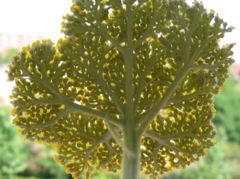Achillea filipendulina: Difference between revisions
No edit summary |
No edit summary |
||
| Line 1: | Line 1: | ||
{{Inc| | |||
Achillea filipendulina, Lam. (A. Eupatorium, Bieb.). Fig. 103. Height 4-5 ft.: st. erect, furrowed, glandular spotted and almost hairy: fls. yellow in dense, convex compound corymbs, often 5 in. across. June-Sept. Orient.—Needs staking. | |||
}} | |||
{{Taxobox | {{Taxobox | ||
| color = lightgreen | | color = lightgreen | ||
Revision as of 08:32, 22 June 2009
| Standard Cyclopedia of Horticulture |
|---|
|
Achillea filipendulina, Lam. (A. Eupatorium, Bieb.). Fig. 103. Height 4-5 ft.: st. erect, furrowed, glandular spotted and almost hairy: fls. yellow in dense, convex compound corymbs, often 5 in. across. June-Sept. Orient.—Needs staking.
|
| Fernleaf Yarrow {{{status}}} Fossil range: {{{fossil_range}}}
| ||||||||||||||||||||||||||||||||||||||||||||||||||||||||||||||||||
|---|---|---|---|---|---|---|---|---|---|---|---|---|---|---|---|---|---|---|---|---|---|---|---|---|---|---|---|---|---|---|---|---|---|---|---|---|---|---|---|---|---|---|---|---|---|---|---|---|---|---|---|---|---|---|---|---|---|---|---|---|---|---|---|---|---|---|
 | ||||||||||||||||||||||||||||||||||||||||||||||||||||||||||||||||||
| Plant Info | ||||||||||||||||||||||||||||||||||||||||||||||||||||||||||||||||||
| ||||||||||||||||||||||||||||||||||||||||||||||||||||||||||||||||||
| Scientific classification | ||||||||||||||||||||||||||||||||||||||||||||||||||||||||||||||||||
| ||||||||||||||||||||||||||||||||||||||||||||||||||||||||||||||||||
| [[{{{diversity_link}}}|Diversity]] | ||||||||||||||||||||||||||||||||||||||||||||||||||||||||||||||||||
| {{{diversity}}} | ||||||||||||||||||||||||||||||||||||||||||||||||||||||||||||||||||
| Binomial name | ||||||||||||||||||||||||||||||||||||||||||||||||||||||||||||||||||
| Achillea filipendulina Lam. | ||||||||||||||||||||||||||||||||||||||||||||||||||||||||||||||||||
| Trinomial name | ||||||||||||||||||||||||||||||||||||||||||||||||||||||||||||||||||
| {{{trinomial}}} | ||||||||||||||||||||||||||||||||||||||||||||||||||||||||||||||||||
| Type Species | ||||||||||||||||||||||||||||||||||||||||||||||||||||||||||||||||||
| {{{type_species}}} | ||||||||||||||||||||||||||||||||||||||||||||||||||||||||||||||||||
| {{{subdivision_ranks}}} | ||||||||||||||||||||||||||||||||||||||||||||||||||||||||||||||||||
| [[Image:{{{range_map}}}|{{{range_map_width}}}|]] | ||||||||||||||||||||||||||||||||||||||||||||||||||||||||||||||||||
| Synonyms | ||||||||||||||||||||||||||||||||||||||||||||||||||||||||||||||||||
| {{{synonyms}}} |
Achillea filipendulina (Fernleaf Yarrow) is ornamental plant in the Asteraceae family. This plant grows 4ft. high, and the foliage, though fern-like, has an untidy appearance, from the irregular way in which it is disposed. It is herbaceous, and comes from the Caucasus. The flowers are somewhat singular, arranged in corymbs of a multiplex character; they are very large, often 5in. across. The smaller corymbs are arched or convex, causing the cluster or compound corymb to present an uneven surface; the small flowers are of rich old gold colour, and have the appearance of knotted gold cord; they are very rigid, almost hard. The leaves are linear, pinnate, lobed and serrated, hairy, rough, and numerously produced. From the untidy and tall habit of this subject, it should be planted in the background; its flowers, however, will claim a prominent position in a cut state; they are truly rich, the undulating corymbs have the appearance of embossed gold plate, and their antique colour and form are compared to gold braid by a lady who admires "old-fashioned" flowers. It will last for several weeks after being cut, and even out of water for many days. A few heads placed in an old vase, without any other flowers, are rich and characteristic, whilst on bronze figures and ewers in a dry state, and more especially on ebony or other black decorations, it may be placed with a more than floral effect. In short, rough as the plant is, it is worth growing for its quaint and rich flowers alone; it is seldom met with. Ordinary garden loam suits it, and its propagation may be carried out at any time by root divisio, in the same way which is used for A. aegyptiaca.
Flowering period, June to September.
- This article incorporates text from the Hardy Perennials and Old Fashioned Flower by John Wood, a publication now in the public domain.
References
- Wood, John (2006). Hardy Perennials and Old Fashioned Flower. Project Gutenberg Literary Archive Foundation.